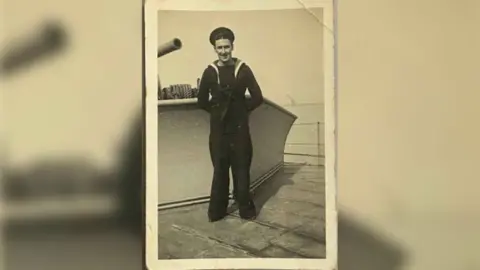Amy Johnson: Fragment of her doomed plane comes up at auction
 Hansons Auctioneers
Hansons AuctioneersA fragment of wreckage believed to be from aviator Amy Johnson's doomed aircraft is to be auctioned.
Ms Johnson, the first woman to fly solo from the UK to Australia, died 11 years after the feat when her plane crashed into the Thames on 5 January 1941.
A piece of debris, believed to be from the plane's parachute door, has only now come to public attention.
It will be sold by Hansons Auctioneers on 28 February, with an estimate of £1,000-£2,000.
 Mirrorpix via Getty Images
Mirrorpix via Getty ImagesMatt Crowson, head of militaria at Hansons, said: "I was amazed to receive an email asking 'Would you be interested in a piece of Amy Johnson's aircraft wreckage?'"
The London-based seller had, according to Mr Crowson, inherited the item from his uncle, Ronald Clark.
Mr Clark is said to have retrieved it from the water and put in his pocket during efforts to rescue Hull-born Ms Johnson.
In 1941 Mr Clark was a Royal Navy able seaman on HMS Berkeley, an escort vessel in the English Channel.
It was one of a number of boats that raced to the crash scene, near Herne Bay, after witnesses reporting seeing a parachute deploy. Ms Johnson's body was never recovered.
 via Hansons Auctioneers
via Hansons AuctioneersMr Crowson said the fragment, believed to be from the Airspeed Oxford plane, was significant.
"No other pieces of the aircraft are thought to exist," he said. "The fragment is constructed from two layers of thin plywood, glued together and set at a 45 degree angle to provide maximum strength.
"The surface paint has been compared to an existing Airspeed Oxford in London's RAF Museum. Given the distinctive green shade and traces of yellow, it's likely the piece was from the parachute exit door. This was the only part of the aircraft constructed from ply, the fuselage section being linen-covered."
After finding the fragment, Mr Clark is said to have inscribed the words "piece of fuselage from Amy Johnson's plane, crashed 1941" on the reverse.
Mr Crowson said checks confirmed the sailor's service on HMS Berkeley, which was sent to the crash site.
"The vendor remembers his uncle telling him the story in the 1950s and showing him the fragment," said Mr Crowson.
"The technical aspects of the style of manufacture, paint colours, service records, anecdotal evidence and the fact that this type of aircraft would not have routinely been in the area, all add up to it being correct."
Before World War Two Ms Johnson worked as a commercial pilot, a journalist and even a fashion model. Early in the war she joined the Air Transport Auxiliary, which transported RAF aircraft around the country.

Follow BBC East Yorkshire and Lincolnshire on Facebook, X (formerly Twitter), and Instagram. Send your story ideas to [email protected]
